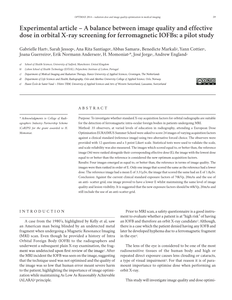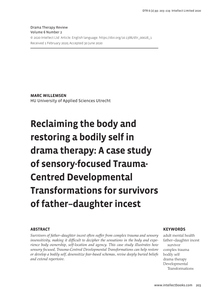The aim of the study was to investigate if and how body image, taken from a contextual perspective, contributes to the eating disorder history. This qualitative study investigated the process of eating disorder development in eight elite women athletes in at-risk sports. The results showed that the relationship between eating disorder symptomatology and the sports environment was clearly recognized by the elite women athletes. Contextual body image, more specifically negative body-evaluations and upward body comparisons, appeared as an important factor in the development of eating disorders, particularly in the athletic context. It became clear that the two aesthetic and two endurance athletes as well as the two weight-class athletes in rowing described quite negative body evaluations in the context of sport, while some of them also recognized an impact of body image experiences in daily life. However, for both judokas, their eating disorder had nothing to do with their body image but was attributed to the weight-classes in their sport and accompanying weight making. Several unique trajectories and individual eating disorder histories were distinguished which confirms the value of taking a qualitative approach in investigating eating disorders in sport. We also discovered links between what the athletes had reported as contributors to their eating disorder history and how they told their stories by combining content analysis and narrative inquiry. Furthermore, the present study also highlights several critical aspects for prevention and treatment that should support sport federations and clinical sport psychologists in taking appropriate actions to deal more effectively with eating disorders in athletes.
LINK
Background: To assess the prevalence of chronic lymphedema and trismus in patients > 6 months after head and neck cancer (HNC) treatment, and to explore how the severity of these conditions correlates with body image and quality of life. Methods: The cross-sectional sample included 59 patients, treated for HNC between six months to three years ago. Physical measurements were performed to assess the presence of external lymphedema and trismus (<36 mm). Furthermore, participants completed two questionnaires regarding body image (BIS) and quality of life (UW-QoL V4). Results: Lymphedema prevalence was 94.1% (95% CI 0.86–0.98), with a median severity score of 9 (range 0–24). Trismus prevalence in this sample was 1.2%. The median BIS score was 2, indicating a positive body image. The UW-QoL score showed a good QOL with a median of 100. Only the domain of saliva and overall related health had a lower median of 70 and 60, respectively. There was no correlation between lymphedema and body image (r = 0.08, p = 0.544). Patients with higher lymphedema scores reported poorer speech with a moderate correlation (r = −0.39, p = 0.003). Conclusion: Lymphedema is a highly prevalent, but moderately severe late side-effect of HNC with a limited impact on quality of life domains except for speech, in our cohort.
DOCUMENT

Introduction: In clinical practice AP pelvis standard protocols are suitable for average size patients. However, as the average body size has increased over the past decades, radiographers have had to improve their practice in order to ensure that adequate image quality with minimal radiation dose to the patient is achieved. Gonad shielding has been found to be an effective way to reduce the radiation dose to the ovaries. However, the effect of increased body size, or fat thickness, in combination with gonad shielding is unclear. The goal of the study was to investigate the impact of gonad shielding in a phantom of adult female stature with increasing fat thicknesses on SNR (as a measure for image quality) and dose for AP pelvis examination. Methods: An adult Alderson female pelvis phantom was imaged with a variety of fat thickness categories as a representation of increasing BMI. 72 images were acquired using both AEC and manual exposure with and without gonad shielding. The radiation dose to the ovaries was measured using a MOSFET system. The relationship between fat thickness, SNR and dose when the AP pelvis was performed with and without shielding was investigated using the Wilcoxon signed rank test. P-values < 0.05 were considered to be statistically significant. Results: Ovary dose and SNR remained constant despite the use of gonad shielding while introducing fat layers. Conclusion: The ovary dose did not increase with an increase of fat thickness and the image quality was not altered. Implications for practice: Based on this phantom study it can be suggested that obese patients can expect the same image quality as average patients while respecting ALARA principle when using adequate protocols.
DOCUMENT
Purpose: To investigate whether standard X-ray acquisition factors for orbital radiographs are suitable for the detection of ferromagnetic intra-ocular foreign bodies in patients undergoing MRI.Method: 35 observers, at varied levels of education in radiography, attending a European Dose Optimisation EURASMUS Summer School were asked to score 24 images of varying acquisition factors against a clinical standard (reference image) using two alternative forced choice. The observers were provided with 12 questions and a 5 point Likert scale. Statistical tests were used to validate the scale, and scale reliability was also measured. The images which scored equal to, or better than, the reference image (36) were ranked alongside their corresponding effective dose (E), the image with the lowest dose equal to or better than the reference is considered the new optimum acquisition factors.Results: Four images emerged as equal to, or better than, the reference in terms of image quality. The images were then ranked in order of E. Only one image that scored the same as the reference had a lower dose. The reference image had a mean E of 3.31μSv, the image that scored the same had an E of 1.8μSv.Conclusion: Against the current clinical standard exposure factors of 70kVp, 20mAs and the use of an anti- scatter grid, one image proved to have a lower E whilst maintaining the same level of image quality and lesion visibility. It is suggested that the new exposure factors should be 60kVp, 20mAs andstill include the use of an anti-scatter grid.
DOCUMENT

Summary Purpose The purpose of this study was to investigate the adoption and actual use of a digital dietary monitoring system (DDMS) and its impact on patient satisfaction with the provided hospital care, body weight changes and health-related quality of life (HRQoL) in patients with potentially curable esophageal cancer planned for surgery. The DDMS enables patients and dietitians to monitor patients' nutritional intake and body weight during the preoperative period. Methods In this prospective observational study, the first 47 included patients received usual nutritional care, and were followed from diagnosis until surgery. After implementation of the DDMS 37 patients were followed, again from diagnosis until surgery. Main outcomes were actual use of the DDMS, by means of adoption and usage measures, overall patient satisfaction (EORTC-INPATSAT32), weight change and HRQoL (EORTC QLQ-C30 and EORTC-OG25). Outcomes were assessed immediately after diagnosis, and 6 and 12 weeks later. Results The system had an adoption rate of 64% and a usage rate of 78%. No significant effects on patient satisfaction were found at 12 weeks after diagnosis between the intervention and the usual care group. The implementation of the DDMS also had no significant effect on body weight and HRQoL over time. Conclusions Patients with potentially curable esophageal cancer planned for surgery were able to use the DDMS. However, no significant effects on patient satisfaction, body weight changes and HRQoL were observed. Further research should focus on the specific needs of patients regarding information and support to preoperatively optimize nutritional intake and nutritional status.
MULTIFILE

Survivors of father–daughter incest often suffer from complex trauma and sensory insensitivity, making it difficult to decipher the sensations in the body and experience body ownership, self-location and agency. This case study illustrates how sensory focused, Trauma-Centred Developmental Transformations can help restore or develop a bodily self, desensitize fear-based schemas, revise deeply buried beliefs and extend repertoire.
DOCUMENT

New social actors have emerged with the social media. Among them, we highlightedthe digital influencers, people who have millions of online followers, andinduce them in favor or against products and brands to be consumed. Therefore,we aimed to analyze this endorsement process carried out by digital influencers intheir online profiles, having as research field the fitness market that encouragespeople to evaluate and work tirelessly in their bodies. We used the Semiotic ImageAnalysis to investigate the postings of three Brazilian digital fitness influencersand identified four categories that configure the post format: body exposure, bodyextension, interaction between influencer and brand/product, and interaction betweeninfluencer and followers. By means of these categories, we identified thatthese influencers act as brand avatars, creating an intense link with these products,exposing their bodies in advertisements and extending the meanings of theirgood shape to endorsed goods and services.
MULTIFILE
Rationale: Patients with cancer of the upper gastrointestinal tract or lung are more likely to present with malnutrition at diagnosis than, for instance, patients with melanoma. Low muscle mass is an indicator of malnutrition and can be determined by computed tomography (CT) analysis of the skeletal muscle index (SMI) at the 3rd lumbar vertebra (L3) level. However, CT images at L3 are not always available. At each vertebra level, we determined if type of cancer, i.e., head and neck cancer (HNC), oesophageal cancer (OC) or lung cancer (LC) vs. melanoma (ME) was associated with lower SMI. Methods: CT images from adult patients with HNC, OC, LC or ME were included and analyzed. Scans were performed in the patient’s initial staging after diagnosis. MIM software version 7.0.1 was used to contour the muscle areas for all vertebra levels. Skeletal muscle area was corrected for stature to calculate SMI (cm2/m2). We tested for the association of HNC, OC, or LC diagnosis vs ME with SMI by univariate and multivariate linear regression analyses. In the multivariate analyses, age (years), sex, and body mass index (BMI; kg/m2) were included. Betas (B;95%CI) were calculated and statistical significance was set at p
DOCUMENT
Aim and method: To examine in obese people the potential effectiveness of a six-week, two times weekly aquajogging program on body composition, fitness, health-related quality of life and exercise beliefs. Fifteen otherwise healthy obese persons participated in a pilot study. Results: Total fat mass and waist circumference decreased 1.4 kg (p = .03) and 3.1 cm (p = .005) respectively. The distance in the Six-Minute Walk Test increased 41 meters (p = .001). Three scales of the Impact of Weight on Quality of Life-Lite questionnaire improved: physical function (p = .008), self-esteem (p = .004), and public distress (p = .04). Increased perceived exercise benefits (p = .02) and decreased embarrassment (p = .03) were observed. Conclusions: Aquajogging was associated with reduced body fat and waist circumference, and improved aerobic fitness and quality of life. These findings suggest the usefulness of conducting a randomized controlled trial with long-term outcome assessments.
DOCUMENT

Objective: In myocardial perfusion single-photon emission computed tomography (SPECT), abdominal activity often interferes with the evaluation of perfusion in the inferior wall, especially after pharmacological stress. In this randomized study, we examined the effect of carbonated water intake versus still water intake on the quality of images obtained during myocardial perfusion images (MPI) studies. Methods: A total of 467 MIBI studies were randomized into a carbonated water group and a water group. The presence of intestinal activity adjacent to the inferior wall was evaluated by two observers. Furthermore, a semiquantitative analysis was performed in the adenosine subgroup,using a count ratio of the inferior myocardial wall and adjacent abdominal activity. Results: The need for repeated SPECT in the adenosine studies was 5.3 % in the carbonated water group versus 19.4 % in the still water group (p = 0.019). The inferior wall-to-abdomen count ratio was significantly higher in the carbonated water group compared to the still water group (2.11 ± 1.00 vs. 1.72 ± 0.73, p\0.001). The effect of carbonated water during rest and after exercise was not significant. Conclusions: This randomized study showed that carbonated water significantly reduced the interference of extra-cardiac activity in adenosine SPECT MPI. Keywords: Extra-cardiac radioactivity, Myocardial SPECT, Image quality enhancement, Carbonated water
DOCUMENT
